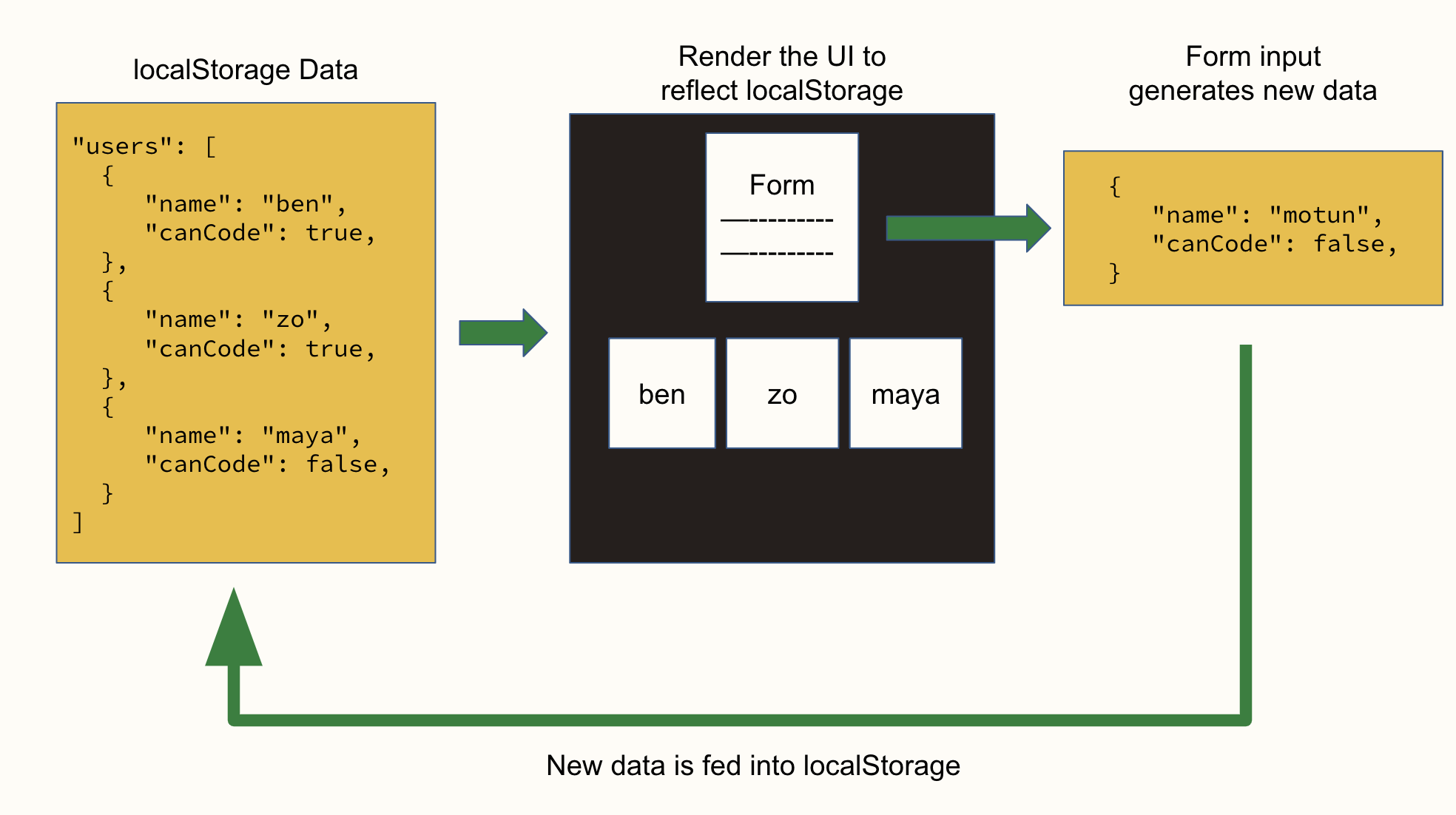Table of Contents
- What is localStorage?
- Setting and Getting Values
- toString() vs. JSON.stringify()
- Stringify and Parse
localStorageHelpers- Data Layer
The localStorage interface allows you to store data across browser sessions.
It is an Object that is available on the window (it is globally available) and it has 4 methods:
localStorage.setItem(key, valueString)localStorage.getItem(key)localStorage.removeItem(key)localStorage.clear()
Storing data in a user's localStorage is like storing data in an Object. Every value we store is associated with a key.
- We store (set) values using
localStorage.setItem(key, valueString) - We retrieve (get) values using
localStorage.getItem(key)
Note: localStorage can only store strings which we have to watch out for.
localStorage.setItem('luckyNumber', 13);
localStorage.setItem('favoriteColor', 'purple');
const storedNumber = localStorage.getItem('luckyNumber');
const storedColor = localStorage.getItem('favoriteColor');
console.log(storedNumber); // 13
console.log(storedColor); // purple
console.log(typeof storedNumber); // string
console.log(typeof storedColor); // stringWhen using setItem, the value is turned into a string before being stored. It does this using the given value's .toString() method (every data type has this method).
As you can see, this is particularly annoying when dealing with Arrays and Objects because of the way that they get turned into strings.
const num = 13;
const bool = true;
const str = 'purple';
const arr = [1, 2, 3];
const obj = { name: 'ben' };
console.log(num.toString()); // '13'
console.log(bool.toString()); // 'true'
console.log(str.toString()); // 'purple'
console.log(arr.toString()); // '1,2,3' <-- mildly annoying that the [] are gone
console.log(obj.toString()); // '[object Object]' <-- what is this garbage??
// JSON.stringify() is much better
console.log(JSON.stringify(arr)); // [1, 2, 3]
console.log(JSON.stringify(obj)); // { name: 'ben' }However, the JSON.stringify() method preserves the structure of Arrays and Objects.
Before storing values in localStorage, we should JSON.stringify() them.
const instructors = ['ben', 'gonzalo', 'motun', 'zo', 'carmen'];
const user = { name: 'ben', canCode: true };
// We typically will JSON.stringify() the value before we set it...
localStorage.setItem('instructors', JSON.stringify(instructors));
localStorage.setItem('user', JSON.stringify(user));
// ...and JSON.parse() the value when we get it:
const storedInstructors = JSON.parse(localStorage.getItem('instructors'));
const storedUser = JSON.parse(localStorage.getItem('user'));
console.log('storedInstructors:', storedInstructors);
console.log('storedUser:', storedUser);When retrieving a value from localStorage, we use the JSON.parse() method which takes a string and tries to turn it into a value
That's quite a bit of code to write and re-write every time we can to set or get values to/from localStorage.
To reduce repetition, we often write these two helper functions:
const setLocalStorageKey = (key, value) => {
localStorage.setItem(key, JSON.stringify(value))
}
const getLocalStorageKey = (key) => {
try {
return JSON.parse(localStorage.getItem(key))
} catch (err) {
console.error(err);
return null;
}
}We wrap the JSON.parse() function invocation in a try/catch block in the event that JSON.parse() can't determine the value type of the given string.
- If it can, it will return the value.
- If it can't, the error will be printed (and not break everything) and
nullwill be returned.
Now, we can safely use these functions instead of the localStorage ones and know that all values will be properly stored and retrieved.
setLocalStorageKey('nums', [1, 2, 3])
const storedArr = getLocalStorageKey('nums');
setLocalStorageKey('user', { name: 'ben' });
const storedUser = getLocalStorageKey('user');
console.log(storedArr); // [1, 2, 3]
console.log(storedUser); // { name: 'ben' }As you can see, working with localStorage can be quite tricky. We want to ensure that our application works in a consistent and predictable manner.
To achieve this, we will typically:
- isolate the logic for dealing with
localStoragein its own file. - create functions for interacting with
localStorage. - only export the functions that indirectly interact with
localStorage.
This way, we create a consistent and predictable interface.
// local-storage.js
// Generic localStorage helpers
const setLocalStorageKey = (key, value) => {
localStorage.setItem(key, JSON.stringify(value))
}
const getLocalStorageKey = (key) => {
try {
return JSON.parse(localStorage.getItem(key))
} catch (err) {
console.error(err);
return null;
}
}
// These two will be used by the rest of the functions a lot
export const getNames = () => getLocalStorageKey('names');
export const setNames = (names) => setLocalStorageKey('names', names);
// More helper functions
export const initializeNames = () => setNames(['ben', 'gonzalo', 'motun']);
export const addName = (name) => {
const names = getNames();
setNames([...names, name]);
}
export const removeName = (nameToRemove) => {
const names = getNames().filter((name) => name !== nameToRemove);
setNames([...names]);
}And always remember to test your code!
// mains.js
import { initializeNames, addName, getNames } from './local-storage.js';
initializeNames();
console.log(getNames()); // ['ben', 'gonzalo', 'motun']
addName('carmen');
addName('zo');
console.log(getNames()); // ['ben', 'gonzalo', 'motun', 'carmen', 'zo]
removeName('ben');
console.log(getNames()); // ['gonzalo', 'motun', 'carmen', 'zo]Q: What makes this predictable and consistent?
Answer
This is predictable and consistent because
- we control what the user of these functions can do (set, get, initialize, add, remove)
- the caller of those exported functions doesn't directly interact with
localStorage - the exported functions handle the interaction with
localStorage
Sure, we can interact with localStorage outside of this file too but we should avoid that if we want to maintain the predictable and consistent behavior.
That file acts as a data layer. We might also decide to isolate our DOM manipulation code and create a DOM layer or create an event handling layer.
Using localStorage, we will build a data layer that is used to inform what is rendered, know as the view layer. When users interact with the view through the form, the data layer will be updated and we re-render the view.
This cycle of data > view > handle events > data looks like this:
